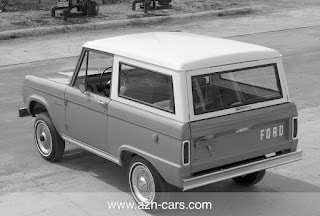The thought behind the Bronco started with Ford item administrator Donald N. Frey in the mid 1960s (who likewise imagined the Ford Mustang) and built by Ford engineer Paul G. Axelrad, with Lee Iacocca supporting the last model for creation in February 1964, after the main mud models were implicit mid-1963. Created as a rough terrain vehicle (ORV), the Ford Bronco was planned as a contender for the Jeep CJ-5 and International Harvester Scout. Today a smaller SUV as far as size, Ford showcasing shows an early case of advancing a non military personnel wilderness romper as a "Sports Utility" (the two-entryway pickup variant). At first selling admirably, following the presentation of the Chevrolet Blazer, Jeep Cherokee, and International Scout II (from 1969 to 1974), request moved towards SUVs with better on-street capacity, prompting a decrease sought after for the Ford Bronco.
Case
The original Ford Bronco is based upon a case grew explicitly for the model range, mutual with no other Ford or Lincoln-Mercury vehicle. Based on a 92-inch wheelbase (measured between the CJ-5 and Scout; just an inch shorter than the later CJ-7), the Ford Bronco utilized box-segment body-on-outline development.
To improve creation, all models were sold with four-wheel drive; a move on the-fly Dana 20 exchange case and bolting center points were standard. The back hub was a Ford 9-inch hub, with Hotchkiss drive and leaf springs; the front pivot was a Dana 30, supplanted by a Dana 44 of every 1971. As opposed to the Twin I-Beams of bigger Ford trucks, the Bronco utilized sweep arms to find the loop sprung front pivot, alongside a parallel track bar, taking into account a 34-foot turning circle, long wheel travel, and antidive math (valuable for snowplowing). A heavier-obligation suspension framework was an alternative, alongside air front springs.Powertrain
At its August 1965 dispatch, the Ford Bronco was offered with a 170-cubic-inch inline six. Gotten from the Ford Falcon, the 105-hp motor was adjusted with strong valve lifters, a 6-US-quart (6 L) oil skillet, hard core fuel siphon, oil-shower air cleaner, and carburetor with a buoy bowl repaid against inclining. In March 1966, a 200-hp 289-cubic-inch V8 was presented as an alternative. For the 1969 model year, the 289 V8 was expanded to 302 cubic inches, staying through the 1977 model year. For 1973, a 200 cubic-inch inline six turned into the standard motor, offered through 1977.
To bring down creation costs, at its dispatch, the Bronco was offered exclusively with a three-speed, section moved manual transmission and floor-mounted exchange case shifter (with a story mounted transmission shifter later turning into a famous alteration). In 1973, in light of purchaser request, a three-speed programmed transmission was offered as a choice.
Body plan
In a focal subject of the original Ford Bronco, styling was subjected to straightforwardness and economy, so all glass was level, guards were straight C-segments, and the left and right entryway skins were balanced (preceding the fitment of entryway mounting equipment).
For 1966, three body arrangements were offered, including a two-entryway cart and half-taxi pickup, and open-body roadster. At its $2,194 base cost ($17,507 in 2018 dollars), the Bronco included barely any courtesies as standard. In any case, an enormous number of alternatives were offered through both Ford and its sellers, including front container situates, a back seat, a tachometer, and a CB radio, just as useful things, for example, a tow bar, an assistant gas tank, a force remove, a snowplow, a winch, and a posthole digger. Reseller's exchange frill included campers, overdrive units, and the standard cluster of wheels, tires, skeleton, and motor parts for expanded execution.
For 1967, Ford presented the Sport alternative bundle for the Bronco cart. Comprising fundamentally of chrome outside trim and wheelcovers, the Sport bundle was recognized by red-painted FORD grille lettering. For 1970, the Bronco Sport turned into an unsupported model as opposed to an alternative bundle.
To consent to government guidelines, the Bronco was fitted with reinforcement lights and side marker lights (in 1967 and 1968, separately). In the wake of battling with deals, the open-body Bronco roadster was pulled back after the 1968 model year.
After 1972, the Bronco half-taxi was pulled back; alongside its lower deals contrasted with the cart, Ford had presented the bigger Ford Courier smaller pickup.
In a minor modification, for 1977, the outside mounted fuel tank tops were supplanted behind pivoted entryways (as on all other Ford trucks).
Trim
Inititally offered as a solitary trim level with a long alternative rundown, for 1967, Ford presented the Sport choice bundle for the Bronco cart. Comprising principally of chrome outside trim and wheelcovers, the Sport bundle was recognized by red-painted FORD grille lettering. For 1970, the Bronco Sport turned into an unsupported model instead of a choice bundle.
For 1972, in accordance with the F-Series trucks, the Ranger trim turned into the first in class Bronco, offering body stripes, model-explicit wheel covers, material seats, woodgrain entryway boards, and covered inside.
In a 1975 inside update, the Bronco Sport and Bronco Ranger adjusted the two-talked controlling wheel from the F-Series.























